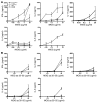Spontaneous opticospinal encephalomyelitis in a double-transgenic mouse model of autoimmune T cell/B cell cooperation
- PMID: 16955140
- PMCID: PMC1555668
- DOI: 10.1172/JCI28330
Spontaneous opticospinal encephalomyelitis in a double-transgenic mouse model of autoimmune T cell/B cell cooperation
Abstract
We describe a double-transgenic mouse strain (opticospinal EAE [OSE] mouse) that spontaneously develops an EAE-like neurological syndrome closely resembling a human variant of multiple sclerosis, Devic disease (also called neuromyelitis optica). Like in Devic disease, the inflammatory, demyelinating lesions were located in the optic nerve and spinal cord, sparing brain and cerebellum, and the murine lesions showed histological similarity with their human correlates. OSE mice have recombination-competent immune cells expressing a TCR-alphabeta specific for myelin oligodendrocyte glycoprotein (MOG) aa 35-55 peptide in the context of I-Ab along with an Ig J region replaced by the recombined heavy chain of a monoclonal antibody binding to a conformational epitope on MOG. OSE mouse B cells bound even high dilutions of recombinant MOG, but not MOG peptide, and processed and presented it to autologous T cells. In addition, in OSE mice, but not in single-transgenic parental mice, anti-MOG antibodies were switched from IgM to IgG1.
Figures







Comment in
-
A mighty mouse: building a better model of multiple sclerosis.J Clin Invest. 2006 Sep;116(9):2313-6. doi: 10.1172/JCI29834. J Clin Invest. 2006. PMID: 16955130 Free PMC article.
References
-
- Lassmann H., Brück W., Lucchinetti C. Heterogeneity of multiple sclerosis pathogenesis: implications for diagnosis and therapy. Trends Mol. Med. 2001;7:115–121. - PubMed
-
- Bach J.-F. The effect of infections on susceptibility to autoimmune and allergic diseases. . N. Engl. J. Med. 2002;347:911–920. - PubMed
Publication types
MeSH terms
Substances
LinkOut - more resources
Full Text Sources
Other Literature Sources
Molecular Biology Databases

